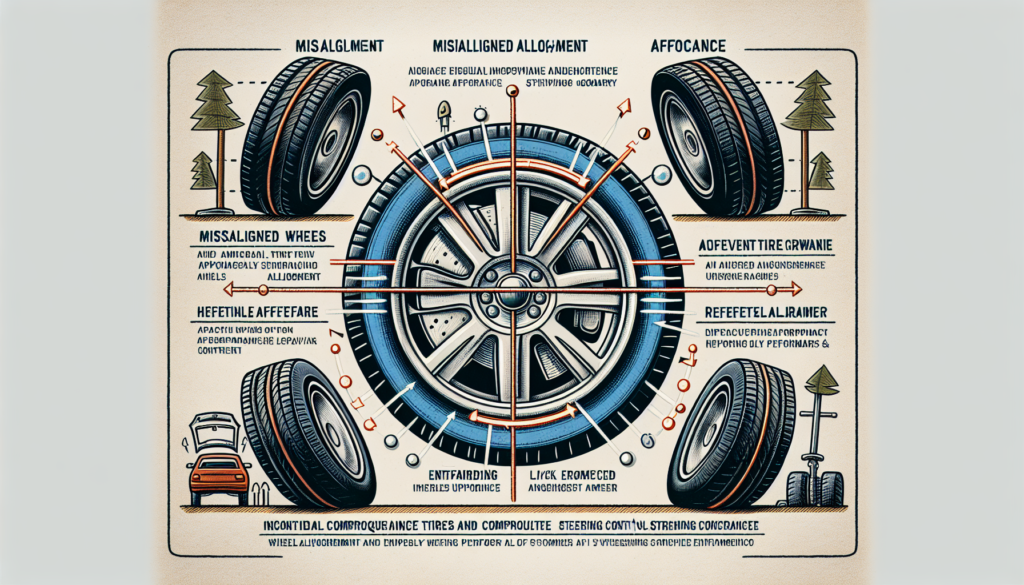Have you ever wondered how improper wheel alignment can impact your steering geometry? Ensuring your wheels are properly aligned is crucial for maintaining optimal control and safety while driving. When your wheels are out of alignment, it can lead to a host of issues, including uneven tire wear, decreased fuel efficiency, and most importantly, compromised steering performance. In this article, we will explore the relationship between wheel alignment and steering geometry, and the potential consequences of neglecting this important aspect of vehicle maintenance. So, buckle up and let’s dive into the fascinating world of wheel alignment!
Overview of Wheel Alignment and Steering Geometry
Understanding Wheel Alignment
When it comes to ensuring your vehicle performs at its best, wheel alignment is a crucial aspect that shouldn’t be overlooked. Simply put, wheel alignment refers to the positioning of your vehicle’s wheels in relation to each other and the surface of the road. It involves adjusting the angles of the tires so that they are parallel to each other and perpendicular to the ground. By maintaining proper wheel alignment, you can optimize steering response, tire wear, and overall driving experience.
Defining Steering Geometry
Steering geometry, on the other hand, encompasses a set of parameters that determine how the wheels respond to driver input and interact with the road. It refers to the angles and alignment of various suspension components, such as the steering linkage, tie rods, and control arms. Steering geometry directly influences the stability, handling, and control of your vehicle. It is essential for smooth steering, accurate tracking, and a safe driving experience.
Effects of Improper Wheel Alignment on Steering Geometry
Altered Toe Angle
One of the most significant effects of improper wheel alignment on steering geometry is an altered toe angle. Toe angle refers to the angle formed by the tires when viewed from above. When the toe angle is incorrect, that is, if the wheels are not parallel to each other, issues arise. With a toe angle that is either toe-in (wheels pointing inward) or toe-out (wheels pointing outward), the tires tend to scrub against the road surface, causing uneven tire wear and reduced fuel efficiency. Moreover, an improper toe angle can result in instability, decreased steering response, and potential vibrations.
Impact on Camber Angle
Camber angle refers to the tilt of the wheels regarding their vertical alignment. Improper wheel alignment can cause the camber angle to deviate from the manufacturer’s specifications. When the camber angle is off, it can lead to uneven tire wear, particularly on the inner or outer edges of the tires. Additionally, incorrect camber angle affects the vehicle’s handling and stability. Excessive positive or negative camber angle influences the contact patch between the tire and the road, resulting in reduced grip and compromised cornering ability.
Changes in Caster Angle
The caster angle is the forward or backward tilt of the steering axis when viewed from the side of the vehicle. An improper caster angle, resulting from wheel alignment issues, can significantly impact the vehicle’s steering stability. Inadequate caster angle can lead to a lack of self-centering ability, causing the steering wheel to feel heavy and difficult to turn. It can also result in steering wheel vibration and a tendency to wander or pull to one side while driving.
Uneven Tire Wear
Another consequence of improper wheel alignment is uneven tire wear. When the wheels are not properly aligned, certain areas of the tires bear more load and friction than others. As a result, accelerated and uneven tire wear patterns emerge, such as feathering, cupping, or excessive wear on one side of the tire. Uneven tire wear not only wears down the tires prematurely but also reduces traction, handling, and overall tire performance. Moreover, it can lead to costly tire replacements and compromise road safety.
Reduced Steering Response
Proper wheel alignment is crucial for maintaining optimum steering response. When the wheels are misaligned, the vehicle’s steering response becomes compromised. This can manifest as delayed or sluggish response to steering input, making it difficult to navigate around obstacles or make precise maneuvers. Reduced steering response not only affects the overall driving experience but also poses a safety risk, especially in emergency situations that require quick and accurate steering.
Increased Steering Effort
Improper wheel alignment puts additional strain on the steering system, resulting in increased steering effort. When the wheels are not aligned correctly, your vehicle’s steering components have to work harder to compensate for the misalignment. This can lead to excessive wear and premature failure of steering and suspension components, such as the steering rack, tie rods, and ball joints. Increased steering effort can make driving more challenging and tiring, as you constantly need to apply more force to maintain control of the vehicle.

1. Understanding Wheel Alignment
Definition of Wheel Alignment
Wheel alignment refers to the adjustment of the angles of the tires so that they are parallel to each other and perpendicular to the ground. It involves adjusting the camber, toe, and caster angles to ensure optimal tire performance, handling, and steering response.
Components of Wheel Alignment
Wheel alignment requires adjusting three key angles: camber angle, toe angle, and caster angle. The camber angle determines the tilt of the wheels concerning their vertical alignment, the toe angle reflects the inclination of the wheels when viewed from above, and the caster angle represents the forward or backward tilt of the steering axis.
Importance of Proper Wheel Alignment
Proper wheel alignment is essential for various reasons. Firstly, it ensures even tire wear, maximizing the lifespan and performance of your tires. Secondly, it optimizes your vehicle’s handling, steering response, and overall driving experience. Finally, proper wheel alignment contributes to fuel efficiency by reducing unnecessary tire drag and rolling resistance.
2. Defining Steering Geometry
Explanation of Steering Geometry
Steering geometry refers to the arrangement and alignment of various suspension components that enable your vehicle to respond to steering input and maintain stability. It involves a complex system of linkages, arms, and angles that work together to determine how the wheels interact with the road.
Key Parameters in Steering Geometry
The key parameters in steering geometry include the toe angle, camber angle, caster angle, and steering axis inclination. Each parameter influences the vehicle’s stability, turning radius, straight-line tracking, and overall handling characteristics.
Purpose of Steering Geometry
The primary purpose of steering geometry is to provide stability, control, and precise steering response. It ensures that your vehicle maintains a straight trajectory when driving in a straight line and responds accurately to steering inputs, allowing for easy maneuvering and safe handling.

3. Altered Toe Angle
Definition and Explanation of Toe Angle
Toe angle refers to the angle formed by the tires when viewed from above. It can be either toe-in (wheels pointing inward towards each other) or toe-out (wheels pointing outward away from each other). The toe angle is crucial for maintaining proper tire performance, stability, and even wear.
Effect of Incorrect Toe Angle
Incorrect toe angle can have several adverse effects on your vehicle’s steering geometry. Excessive toe-in or toe-out can lead to uneven tire wear, reduced fuel efficiency, and impaired handling. It can also cause tire scrubbing, where the tires fight each other instead of rolling smoothly, resulting in increased rolling resistance and decreased tire lifespan.
Tire Wear Patterns Associated with Toe Misalignment
Misaligned toe angle can result in specific tire wear patterns. Toe-in misalignment may cause excessive wear on the outer edges of the tires, while toe-out misalignment can lead to accelerated wear on the inner edges. These wear patterns compromise traction, stability, and overall tire performance, necessitating premature tire replacements.
4. Impact on Camber Angle
Defining Camber Angle
Camber angle refers to the tilt of the wheels concerning their vertical alignment. It can be positive (top of the tire tilted outward) or negative (top of the tire tilted inward). Camber angle affects tire contact with the road surface and plays a significant role in ensuring proper tire wear and handling.
Consequences of Improper Camber Angle
Improper camber angle due to wheel misalignment can lead to various consequences. Excessive positive or negative camber can result in uneven tire wear, reduced grip, and compromised handling. It can also affect the vehicle’s stability and may cause the vehicle to pull to one side while driving.
Uneven Tire Wear and Camber Misalignment
Misaligned camber angle often leads to uneven tire wear. Excessive positive camber can cause wear on the outer edges of the tires, while excessive negative camber can result in wear on the inner edges. Both scenarios can decrease traction, compromise cornering ability, and necessitate premature tire replacements.

5. Changes in Caster Angle
Explanation of Caster Angle
Caster angle refers to the forward or backward tilt of the steering axis when viewed from the side of the vehicle. It plays a vital role in steering stability, self-centering ability, and overall handling characteristics.
Influence of Improper Caster Angle
Improper caster angle, caused by wheel misalignment, can significantly impact steering stability. Insufficient caster angle reduces the vehicle’s self-centering ability and tends to make the steering wheel feel heavy and less responsive. Excessive caster angle, on the other hand, can lead to a tendency to oversteer or wander, making it more challenging to maintain a straight trajectory.
Effects on Steering Stability
A proper caster angle is essential for maintaining steering stability and ensuring a smooth driving experience. When the caster angle is misaligned, it can result in steering wander, increased steering effort, and decreased overall control of the vehicle. Correcting wheel alignment can rectify these issues and promote safer and more comfortable driving.
6. Uneven Tire Wear
Causes and Effects of Uneven Tire Wear
Uneven tire wear can occur due to various factors, including improper wheel alignment. When the tires are subjected to uneven forces and loads, certain areas of the tire wear down more quickly than others. This leads to irregular patterns of tire wear, compromising traction, handling, and overall tire performance.
Relation to Wheel Alignment
Wheel alignment plays a significant role in preventing uneven tire wear. Correct alignment ensures that the tires are positioned at the optimal angles, allowing for even distribution of forces and load on the tires. By maintaining proper alignment, you can minimize the risk of uneven tire wear and extend the lifespan of your tires.
Types of Tire Wear Patterns
Improper wheel alignment can result in specific tire wear patterns. These include feathering, which refers to a series of angled wear patterns on the tire tread, and cupping, which manifests as uneven depressions or scalloped edges on the tire surface. These wear patterns indicate misalignment and should be addressed promptly to avoid further damage and potential safety hazards.

7. Reduced Steering Response
How Improper Alignment Affects Steering Response
Improper wheel alignment can have a significant impact on steering response. When the wheels are misaligned, the vehicle’s ability to respond promptly and accurately to steering inputs is compromised. This can result in delayed or sluggish steering response, making it challenging to navigate corners, avoid obstacles, or maintain control in emergency situations.
Delayed or Inaccurate Steering Input
One of the noticeable effects of improper alignment on steering response is delayed or inaccurate steering input. Misaligned wheels require more effort and time to respond to steering commands, leading to a lag in vehicle maneuverability. This can be frustrating and potentially dangerous, as it reduces your ability to steer quickly and precisely when needed.
Increased Risk of Accidents
Reduced steering response due to improper alignment increases the risk of accidents. In emergency situations, where split-second decisions and immediate steering adjustments are necessary, delayed or inaccurate steering response can have severe consequences. Proper wheel alignment is crucial for maintaining optimal steering responsiveness and ensuring your ability to maintain control and avoid collisions.
Conclusion
Importance of Proper Wheel Alignment
Maintaining proper wheel alignment is vital for various reasons. It promotes even tire wear, optimizing tire performance, and prolonging tire lifespan. Proper alignment also ensures accurate steering response, stability, and control, enhancing both the safety and driving experience of your vehicle.
Regular Maintenance for Steering Geometry
To maintain proper wheel alignment and steering geometry, regular maintenance is essential. Routine inspections and adjustments should be conducted to ensure that the angles and components are within the manufacturer’s specifications. Regular maintenance can prevent issues associated with misalignment, promote optimal performance, and prevent premature wear of steering and suspension components.
Seeking Professional Alignment Services
To achieve precise wheel alignment and maintain optimal steering geometry, it is recommended to seek professional alignment services. Trained technicians equipped with specialized alignment equipment can accurately measure and adjust the alignment angles, ensuring that your vehicle is properly aligned. Professional alignment services provide peace of mind, knowing that your vehicle’s alignment and steering geometry are in expert hands.


